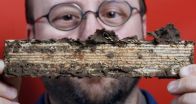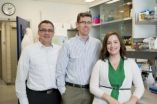Termite genome lays roadmap for 'greener' control measures
2014-05-20
(Press-News.org) WEST LAFAYETTE, Ind. - A team of international researchers has sequenced the genome of the Nevada dampwood termite, providing an inside look into the biology of the social insect and uncovering new genetic targets for pest control.
Michael Scharf, a Purdue University professor of entomology who participated in the collaborative study, said the genome could help researchers develop control strategies that are more specific than the broad-spectrum chemicals conventionally used to treat termite infestations.
"The termite genome reveals many unique genetic targets that can be disrupted for better termite control," said Scharf, who is the O. Wayne Rollins/Orkin Chair in Molecular Physiology and Urban Entomology. "Depending on which gene or protein that is targeted, we could disrupt termites' neurological processes, molting, digestive factors or cuticle formation. We're just limited by our imagination."
The Nevada dampwood termite is the first termite species to have its genome sequenced. While dampwood termites do not cause significant damage to buildings, they are closely related to key pests such as the eastern subterranean termite, which is the main pest species in Indiana and the eastern U.S.
Termites are major pests of human structures, costing an estimated $40 billion in damage and control treatment each year. Having the genome in hand will enable researchers to look for common features expressed across termite species to find control targets effective for all types of termites, Scharf said.
Current termite control measures consist largely of synthetic chemical-based products, some of which are toxic to vertebrates.
"While current pesticides are very effective products, the problem is that you're injecting large volumes of them into the soil around the house," Scharf said. "It would be nice to move to a greener technology, and that's what the genome sequence could enable us to do."
Baiting termites with small quantities of treated wood that they could eat and share with colony-mates would be one such technique, he said. Newer technology such as gene silencing, which targets termite RNA to reduce the expression of critical genes, could also knock out the pests.
"With termites, you don't have to impact all of them," he said. "Targeting just a fraction of the workers could cause an entire colony to collapse."
The study also highlights genes related to chemical communication, the way in which termites "talk" to one another to signal aggression or a desire to reproduce.
"There's a lot of social strife in a termite colony, and it's got to stay cohesive to survive," Scharf said. "Chemical communication is crucial to keeping the labor force in place."
The genome could also help researchers better understand the symbiosis between termites and the more than 4,000 species of bacteria that thrive in their guts, aiding in processes such as digestion and defense. Previous studies of the termite gut were hampered by the inability to distinguish between termite and microbe genes. Understanding the gut biology is important to Scharf, who is researching the enzymes that termites use to digest wood. Identifying these enzymes could lead to novel methods of producing cellulosic biofuels.
"The genome provides a well-defined roadmap that could help us find the right cocktail of enzymes to break wood down into its simple sugars," he said. "It takes a lot of the guesswork out."
INFORMATION:
The study was published in Nature Communications Tuesday (May 20) and is available at http://www.nature.com/ncomms/2014/140520/ncomms4636/full/ncomms4636.html.
Funding for the research was provided by a grant from the U.S. Department of Agriculture's National Institute of Food and Agriculture, the Deutschen Forschungsgemeinscharf and the Loewe Research Focus "Insect Biotechnology."
ELSE PRESS RELEASES FROM THIS DATE:
Fairy circles apparently not created by termites after all
2014-05-20
This news release is available in German. Leipzig. For several decades scientists have been trying to come up with an explanation for the formation of the enigmatic, vegetation-free circles frequently found in certain African grassland regions. Now researchers have tested different prevailing hypotheses as to their respective plausibility. For the first time they have carried out a detailed analysis of the spatial distribution of these fairy circles – and discovered a remarkably regular and spatially comprehensive homogenous distribution pattern. This may best be explained ...
Fossils prove useful in analyzing million year old cyclical phenomena
2014-05-20
Research conducted at the University of Granada has shown that the cyclical phenomena that affect the environment, like climate change, in the atmosphere-ocean dynamic and, even, disturbances to planetary orbits, have existed since hundreds of millions of year ago and can be studied by analysing fossils.
This is borne out by the palaeontological data analysed, which have facilitated the characterization of irregular cyclical paleoenvironmental changes, lasting between less than 1 day and up to millions of years.
Francisco J. Rodríguez-Tovar, Professor de Stratigraphy ...
Improved computer simulations enable better calculation of interfacial tension
2014-05-20
Computer simulations play an increasingly important role in the description and development of new materials. Yet, despite major advances in computer technology, the simulations in statistical physics are typically restricted to systems of up to a few 100,000 particles, which is many times smaller than the actual material quantities used in typical experiments. Researchers therefore use so-called finite-size corrections in order to adjust the results obtained for comparatively small simulation systems to the macroscopic scale. A team of researchers from Johannes Gutenberg ...
Particles near absolute zero do not break the laws of physics after all
2014-05-20
In theory, the laws of physics are absolute. However, when it comes to the laws of thermodynamics—the science that studies how heat and temperature relate to energy—there are times where they no longer seem to apply. In a paper recently published in EPJ B, Robert Adamietz from the University of Augsburg, Germany, and colleagues have demonstrated that a theoretical model of the environment's influence on a particle does not violate the third law of thermodynamics, despite appearances to the contrary. These findings are relevant for systems at the micro or nanometer scale ...
Busting rust with light: New technique safely penetrates top coat for perfect paint job
2014-05-20
WASHINGTON, May 20, 2014 – To keep your new car looking sleek and shiny for years, factories need to make certain that the coats of paint on it are applied properly. But ensuring that every coat of paint—whether it is on a car or anything else—is of uniform thickness and quality is not easy.
Now researchers have developed a new way to measure the thickness of paint layers and the size of particles embedded inside. Unlike conventional methods, the paint remains undamaged, making the technique useful for a variety of applications from cars to artifacts, cancer detection ...
Pine bark substance could be potent melanoma drug
2014-05-20
A substance that comes from pine bark is a potential source for a new treatment of melanoma, according to Penn State College of Medicine researchers.
Current melanoma drugs targeting single proteins can initially be effective, but resistance develops relatively quickly and the disease recurs. In those instances, resistance usually develops when the cancer cell's circuitry bypasses the protein that the drug acts on, or when the cell uses other pathways to avoid the point on which the drug acts.
"To a cancer cell, resistance is like a traffic problem in its circuitry," ...
Flu vaccines in schools limited by insurer reimbursement
2014-05-20
AURORA, Colo. (May 20, 2014) – School-based influenza vaccine programs have the potential to reach many children at affordable costs and with parental support, but these programs are limited by low rates of reimbursement from third-party payers, according to recently published study results by researchers from the University of Colorado School of Medicine.
A school-based flu vaccine program in the Denver Public Schools was effective at reaching nearly one-third of the students, but billing and reimbursement issues posed significant problems for administrators of the program.
"The ...
Study shows how streptococcal bacteria can be used to fight colon cancer
2014-05-20
Researchers at Western University (London, Canada) have shown how the bacteria primarily responsible for causing strep throat can be used to fight colon cancer. By engineering a streptococcal bacterial toxin to attach itself to tumour cells, they are forcing the immune system to recognize and attack the cancer.
Kelcey Patterson, a PhD Candidate at Western and the lead author on the study, showed that the engineered bacterial toxin could significantly reduce the size of human colon cancer tumours in mice, with a drastic reduction in the instances of metastasis. By using ...
Parents of overweight kids more likely to give schools failing grades for fighting obesity
2014-05-20
ANN ARBOR, Mich. – Parents – especially those of overweight children – give schools a failing grade for efforts to encourage healthy habits that combat childhood obesity, according to a new poll from the University of Michigan.
According to the latest University of Michigan C.S. Mott Children's Hospital National Poll on Children's Health, parents with at least one overweight child (25 percent of all parents in the poll) were more likely to give schools a failing grade of D or F for obesity-related efforts than parents of normal-weight children.
Parents of overweight ...
Simulated learning in medical education improves patient care and outcomes
2014-05-20
MAYWOOD, Ill. -- The use of simulation techniques in medical education, such as lifelike mannequins and computer systems, results in improved patient care, better outcomes and other benefits, according to a study led by a Loyola University Chicago Stritch School of Medicine researcher.
William C. McGaghie, PhD, and colleagues analyzed 23 medical education studies that measured the effects of simulation-based mastery learning (SBML). A qualitative synthesis of these studies found that SBML improved outcomes in four areas: the educational laboratory, patient care practices, ...




